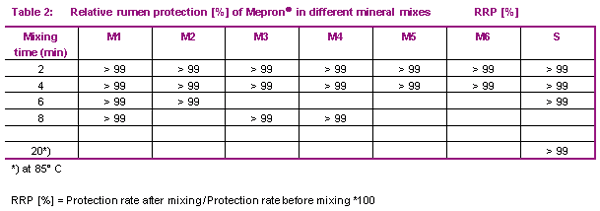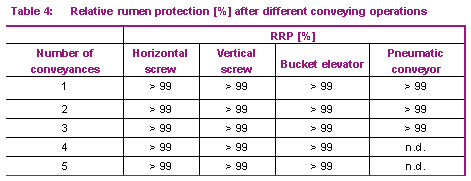
Content sponsored by:
Evonik Animal Nutrition
Mepron® - The best Methionine source for ruminants shows excellent handling properties
Published: August 25, 2019
By: Dr. Claudia Parys
Key information
- Mepron® is a dust free mini pellet (1.8 * 3mm) with a very high degree of durability and low humidity with min. 85 % content of DL-methionine in a rumen protected form. Its specific gravity (1.2 kg/L), bulk density
(650 kg/m3) and angle of repose (21°) assure excellent flow and conveying properties. - Using conventional mixing techniques, the product can be mixed with many types of feed ingredients quickly (2.5 min) and homogeneously (coefficient of variation < 5 %) and remains stable.
- Processed with abrasive or aggressive components (mineral feed, molasses, silage) Mepron®´s protective functions are fully retained. Also mechanical stress incurred in handling the product on conventional conveyors does not impair Mepron®`s functions.
- The excellent nutritional effects in feeding ruminants especially dairy cows are well known and published in brochures and on our web site.
Objectives
It is generally acknowledged that high yielding dairy cows require more methionine in their metabolism than average cows. In response several so called protected methionine products of varying quality have become available in the past. Mepron® has become the product with is taken serious by appliers in the market due to its well proven performance in animal feeding.
After 20 years of practical experience and a lot of investigations concerning our protected methionine source for ruminants this is an overview about properties and the excellent application and processing qualities of Mepron®.
Mechanical properties of Mepron®
An overview about the mechanical properties of Mepron® is given in Table 1:

Mepron® is a pellet (1.8 x3 mm) containing min. 85 % DL-Methionine wrapped in a protective coating which mainly consists of Ethylcellulose. Due to its particle size it can be mixed homogeneously with components with a mean particle size distribution of d50 =1.4-3 mm, which is a typical size in common types of feeds.
Mepron® is virtually dust-free, has a very high durability (> 99.9 %) and low loss on drying (max. 2 %). Its specific gravity (1.2 g/cm3) is in the same range as that of most (organic) mixed feed components namely 1.2 – 1.4 g/cm3.
Bulk density (650 kg/m3) is a prerequisite for determining the capacity of containers and bulk flow on conveyors. In this respect Mepron® also matches the ranges of many other mixed feed components. The angle of repose (21°) which is a measure required to assess flow and conveyor performance confirms excellent performance during conveying and perfect flowability. Components with an angle of repose < 29° are usually said to have favorable mechanical conveying characteristics.
At a maximum of 2 % loss on drying (moisture content) Mepron® has a very low water content compared with other feed mix components.
Mepron® can be mixed homogeneously (CV < 5 %) with most feed ingredients within short mixing times (2.5 min). Those mixtures will not segregate under normal conditions (CV < 3 %). The rate of rumen protection will not decrease when mixed with abrasive or aggressive components (mineral mixes, molasses, silage) or when subjected to heat (85o C) and/or moisture.
The mechanical stress during transport with usual conveyers (screw, elevator, pneumatic transport) is of no effect on the rumen protection of Mepron®. Detailed results can be seen later on. To test its qualities under extreme conditions, Mepron® was exposed in a stress test conducted in a climate chamer at 40° C and 92 % relative atmosheric humidity under pressure corresponding to 1.6 t/m2. Following the 24 h test the product’s abrasion and protective parameters were found to equal the characteristics of unexposed material.
Due to its good mechanical stability the packaging could be switched from cardboard boxes used to 25 kg bags (750 kg/pallet) and 750 kg big bags. 2 pallets can be stacked upon each other also during transportation without damaging the protective coating.
Handling properties of Mepron®
Mixing
In order to determine the mixing properties of Mepron® in ordinary feed a mixing time profile was measured:
Thus 2 % Mepron® were mixed with soybean meal using a single shaft horizontal ribbon mixer with 20 rpm and 90 % loading at 20o C and 74 % of rel. atm. humidity. 8 samples of 250 g each were taken from the mixer after 0.5 up to 4 minutes mixing time. After 2.5 minutes resp. 1.5 minutes a coefficient of variation (CV) of less than 5 % is reached.

For the mixer used in this experiment, mixing time profiles obtained with DL-Methionine or sodium chloride as test substance result in mixing times of 2.5 min as well to get a CV < 5 %. That means, the necessary mixing time for Mepron® corresponds to that of other microingredients. Crumbles are particularly suitable.
Segregation
A sample of a mixture (2 % Mepron® in soybean meal) was released from a bin (diam. 150 mm, height 115 mm, diam. outlet 28 mm, drop 200 mm) to form a cone approx. 60 mm high spread horizontally. The cone was divided into 3 horizontal layers of the same height (approx. 20 mm). Each layer was analysed for its methionine content to calculate the CV %. The result was a very low CV of only 3 %.
Stability during mixing process
Many components - especially additives - are not stable in mixes with other components. Mixes using mineral feed, molasses and silage with protected methionine were therefore of special interest.
In a typical experiment 10 % Mepron® was mixed with 6 different mineral mixes (M1 - M6) and soybean meal (S). A horizontal mixer with plow shaped mixing tools was applied (60 % loading, 19o C, rel. atm. humidity 68 %). Samples were taken after varying mixing intervalls in order to test the influence of the mixing process on the methionine protection in comparison with an untreated sample. By this the relative protection [%] was determined (Table 2).

Even after 8 minutes of mixing and the use of very coarse and very abrasive minerals at times, Mepron® did not lose its protection, which can be seen from the practically unchanged relative protection rate of > 99 %.
A lot of protected methionine compounds, especially with excipients of low melting point, are destroyed by heat treatment. Mepron® however, mixed with soybean meal at 85°C proved to be stable.
Stability in silage
6 different types of silage were mixed with Mepron® (2 %) and stored at room temperature for 48 h. Mepron® proved to be practically 100 % stable.

Stability in molasses
40 % Mepron® were mixed with molasses and stored for 8 days at room temperature. The methionine content as well as the protective capability of Mepron® remained intact after this exposure.

Stability in mineral mixes
After 18 months of storage of mineral premixes including 10 % of Mepron® its protected qualities still remained unchanged.

Conveying
Raw materials, intermediates and finished products require conveying to undergo numerous processing steps in feed manufacturing. To maintain quality the in-plant material handling must be accorded the same care as, say, mixing processes. In particular, conveying equipment such as screw type, elevator or pneumatic installations must not alter or segregate feed and their mixes. Mechanical stress imposed by horizontal and vertical continuous conveyors means a challenge for any protective coating. Therefore, conveying experiments with different typical feed conveying systems were undertaken and relative protection rate after conveying was determined (Table 4).

For example the horizontal screw conveyor (U-shape trough, width 110 mm, depth 120 mm, length 750 mm, 90 rpm) was loaded with Mepron® and conveyed altogether 5 times. After each conveying process the protective function of each sample was tested and compared to untreated material. Analogously the other conveying systems were tested (vertical screw: diameter 127 mm, length 5 m, 800 rpm; bucket elevator: length 4.5 m, 7 buckets of 300 mL each per m, speed 1.75 m/s; pneumatic vacuum conveyer: air volume 100 m3/h at -0.2 bar, diameter of the piping 50 mm, length 20 m with two 90° and one 180° ellbow).
In all cases relative rumen protection rates were > 99 %. This means that typical conveying systems like screw, bucket or pneumatic conveyors do not affect protective coating of Mepron® in any way.
Conclusion
Besides its very good nutritional effectiveness in feeding of dairy cows and other ruminants Mepron® shows excellent mechanical and handling properties like high durability, high stability during typical steps of feed processing and towards aggressive feed components, excellent flowability and mixability as well as low segregation tendency from feed mixtures.
Therefore, Mepron® Feed Grade from Evonik Degussa GmbH is the first choice to supply ruminants reliably with methionine in a helpful and convenient way.
Related topics:
Authors:
Evonik Animal Nutrition
Influencers who recommended :
Markus WiltafskyRecommend
Comment
Share
5 de abril de 2020
The addition of Amino acid to the dairy cows in the formulations came more attention from a few years ago; today most of the farmers are interested in this technology.
The research start up long time ago, as an example when start to study the free methionine and lysine had a relatively high rumen degradation escape values when they were fed to high producing dairy cows (Velle et al., 1997, 1998; Volden et al., 1998).
But this came more popular now when was found that all the amino acid have a complete linked with the bacteriological activity into the digestion process.
As a Dairy Consultant for hot environment’s (in desert, tropical and sub-tropical conditions) we start to develop some trails in the farms using Methionine from different brands, this was a complete new experience because the formulation of the cows to achieve 35-40 lit is not exactly the same like in temperate countries as USA or Europe, also if the principle are the same the feeds quality and the high temperature and moisture has an important influence in the digest process.
About three years ago, we start up some trails in about 4 farms, with about 1 to 2 corrals of 130 cows in each farm with average production of 35 to 40 lit by corral. With the comparative corrals we found that in some cases was not difference in the production with the same formulation, management and environment and only one show a difference of one liter by cow average but it was not economically feasible.
On the following years we continuous testing with different test, and today with about 6,700 milking cows under evaluation we learn the following for hot environment’s:
1) The brand we select is from Kemin as MetiPEARL and LysiPEARL for the best results we had in comparison with other brands (price/quality). 2) When we combine Methionine with Lysine we found better results than using Methionine alone. 3) We found a high reduction in the use of Soybean meal, from 4.5 kg in the original formula to 2.6 kg (according the type of formulation in the farm) keeping the same production. 4) The best improvement was noted in reproduction or conception rate, Fat stability and Protein increase. 5) The best results were noted in the general performance of the cows, more healthy, better BCS (as feed assimilation) and reduction of the minor affections as laminitis, mastitis, etc. 6) The amino acid addition used is a rate of 3/1 (Lys-Met) in base to NRC, and the formulation variation, with about 10 gm. of Met and 20 gm. of Lys (according the formula).
The economic result we do not calculate yet, we consider that some of the results are difficult to evaluate, maybe the most notorious is relate to the reduction of the Soybean Meal used as a directly reduction in the feeding cost.
Gustavo Pourraid Dairy Management Consultancy Services Director of AgriConsultAS LLC
Recommend
Reply

Would you like to discuss another topic? Create a new post to engage with experts in the community.



.jpg&w=3840&q=75)